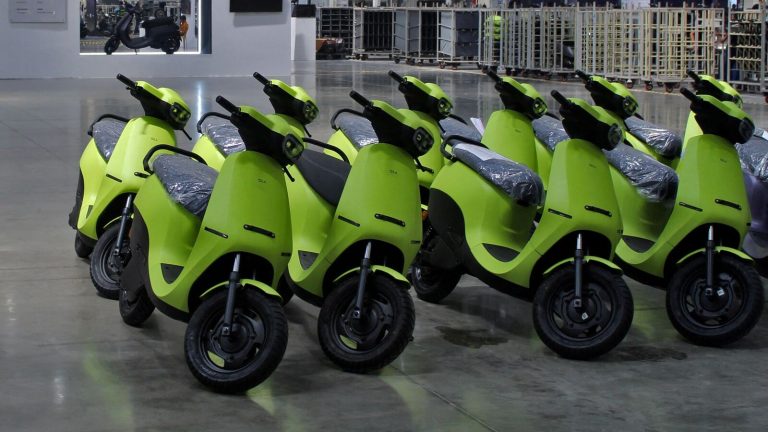Issuing invoices is key to concluding the sale of a product and its delivery as per the country’s taxation laws, and the non-issuance may impact Ola Electric’s revenue booking from these vehicles when it declares its March quarter and fiscal FY25 earnings.
In February, the company said in a communication to the Union roads ministry that it received confirmed orders for 25,207 vehicles in February, which was sharply above the number shown by government registration portal Vahan.
Following a query from the ministry of road transport and highways (MoRTH), the company replied on 7 April that it generated invoices for about 9,206 vehicles during the month. Further, in a clarification to the exchanges on 8 April, the company said 90% of the orders, or 22,686 vehicles, were fully paid for by customers at the time of placing the orders. That leaves a gap of about 13,500 vehicles for which invoices were not generated.
Also read | Ola Electric says it has enough service centres. Govt isn’t buying that
Mint has reviewed the private communications between Ola Electric and the road ministry, as well as the company’s exchange filings over the past month.
In a statement to Mint on 12 April, a company spokesperson highlighted that its usual delivery timeline was affected by the transition of the registration process to in-house teams.
“Our standard vehicle delivery timelines have ranged between 1 to 2 weeks from the date of purchase, depending on the customer’s location and choice of vehicle. Invoices are generated upon vehicle availability, followed by registration and delivery,” the spokesperson said, adding that revenue is only recognized when vehicle registration and delivery are completed.
The development comes in the backdrop of Ola Electric steadily losing ground to rivals in recent months, especially Bajaj Auto and TVS Motor Company, which have been quick off the blocks with new products and offerings.
Read this | Inside Ola Electric’s showdown with registration agencies
In March, data from FADA (Federation of Automobile Dealers associations) showed Bajaj Auto in pole position in retail sales of electric two-wheelers, with TVS Motor in second place and Ola, third. To be sure, Ola led the pack overall in FY25 with retail sales of 344,009 units and a market share of 29.9%, down from its FY24 market share of 34.79%.
The invoice requirement
Invoices, apart from being a record of sale for companies to book revenue, are also a formal record for goods and services tax (GST) purposes. Typically, an invoice contains the details of the customer, the GST amount, the GST number, and the details of the product being sold.
Experts and industry voices said that usually, there isn’t such a huge gap in the generation of invoices and the total sales in a month.
“Invoice for a sale is given immediately or within a few hours. In some cases, it might take a day or two but there isn’t a very long delay,” an executive at a two-wheeler maker said on the condition of anonymity.
Gaurav Makhijani, associate partner and head of tax (North India and Gujarat) at tax consulting firm Roedl & Partner India, pointed out that in case of direct-to-consumer businesses, invoices are usually generated immediately upon making sales.
Also read | Ola Electric’s scooter deliveries hit as it renegotiates contracts with vehicle registration agencies to cut costs
“As per GST law, invoices are mandatorily required to be issued before the movement of goods starts or before the delivery of the goods to the customer,” Makhijani added. “There could be some instances where booking with advance is done prior to the delivery.”
How events unfolded
The issue over Ola Electric’s sales data began when the company reported a huge gap in its Vahan portal registrations and total sales in February. The portal showed about 8,600 vehicles registered by Ola Electric in February, but the company claimed in a statement to exchanges to have sold more than 25,000 vehicles in the month.
Ola told the exchanges that renegotiations with two agencies, Rosmerta Digital Services Pvt. Ltd and Shimnit India Pvt. Ltd, led to a disruption in the registration process.
The roads ministry took note of the gap in the sales and registration data and wrote to the company on 18 March asking for the details of the number of vehicles manufactured, sold and registered in February.
The company replied on 21 March that it received confirmed orders for 25,207 vehicles in February. Notably, these confirmed orders included 1,395 orders for its new motorcycle Roadster X, whose first model was rolled out from its factory on 11 April.
Read this | Weeks after raising funds, Zypp joins Ola Electric in laying off employees
Finding the information provided by the company inadequate, the ministry wrote another letter on 31 March, asking the company to give the number of vehicles it sold and invoiced in February, to which Ola Electric replied that it had invoiced 9,206 orders in February. Of these orders, Ola in its reply to the ministry said that about 7,820 vehicles were delivered to customers till 3 April.
For at least 15% of the total invoiced vehicles in February, the delivery time stretched for more than a month. The company attributed the gap in invoices to the hit to its production process.
“It is important to note that our routine registration process was disrupted during February due to a transition of the process in-house. This impacted registrations and deliveries and, consequently, the production of vehicles during the month,” Ola’s spokesperson said.
Generally, invoice in sales of vehicles contains a vehicle identification number (VIN), which is a unique character code assigned to every vehicle by the manufacturer.
As per Ola’s reply to the government, it manufactured 15,533 vehicles in February.
Since the beginning of the registration saga in February, Ola Electric’s share price has declined by over 17% as against a 6% fall in the BSE Auto index.
And read | Ola Electric may lose subsidy benefit if e-scooter registration delays spill over to FY26


